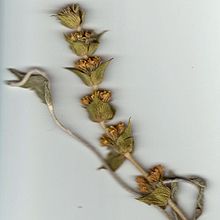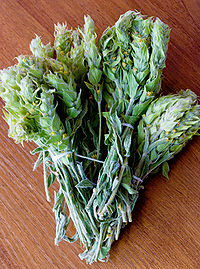- Sideritis
-
Sideritis 
Sideritis syriaca (Mountain Tea) Scientific classification Kingdom: Plantae Division: Angiosperms Class: Magnoliopsida Order: Lamiales Family: Lamiaceae Genus: Sideritis
L.Species Sideritis lanata L.
Sideritis montana L.
Sideritis romana L.
Sideritis (also known as ironwort, mountain tea and shepherd's tea) is a genus of flowering plants well known for their medicinal properties. They are abundant in Mediterranean regions, the Balkans, the Iberian Peninsula and Macaronesia, but can also be found in Central Europe and temperate Asia.[1][2][3][4]
Contents
History and etymology
In Greek "Sideritis" can be literally translated as "he who is or has the iron". The plant was known to ancient Greeks, specifically Dioscorides and Theophrastus.[5] Although Dioscorides describes three species, only one (probably S. scordioides) is thought to relate to Sideritis. In ancient times Sideritis was a generic reference for plants capable of healing wounds caused by iron weapons during battles. However others hold that the name stems from the shape of the sepal which resembles the tip of a spear.[2]
Taxonomy
In 2002, a molecular phylogenetic study found Sideritis and five other genera to be embedded in Stachys.[6] Further studies will be needed before Stachys, Sideritis, and their closest relatives can be revised.
According to the classification scheme of EOL there are three species: Sideritis lanata (hairy ironwort), Sideritis montana (mountain ironwort) and Sideritis romana (simplebeak ironwort).[7]
Some schemes (such as Wikispecies, ITIS and ZipcodeZoo) recognize intermediate subphyla, infraphyla, subclasses and superorders and categorize up to 319 distinct species, subspecies, ecotypes, forms or cultivars, including:[2]
- S. scardica
- S. purpurea Talb. - found in western Greece, the Ionian islands and Crete
- S. remota Urv.
- S. scardica Gris. - also known as Olympus tea
- S. theezans Boiss & Heldr - found in Peloponnese
- S. raiseri Boiss & Heldr
- S. euboea Heldr - found in the island of Euboea
- S. syriaca L., S. cretica Boiss, S. boissieri Magn. - found in Crete and collectively known as Malotira (Μαλοτήρα)
Botanists have encountered difficulties in naming and classifying the varieties of Sideritis due to their subtile differences. One particularly confusing case is that of S. angustifolia Lagasca and S. tragoriganum Lagasca.[8]
Botany
The genus is composed of short (8–50 cm), xerophytic subshrubs or herbs, annual or perennial, that grow at high altitudes (usually over 1000 m) with little or no soil, often on the surface of rocks.[1][4][9][10]
It is pubescent, either villous or coated by a fine, woolly layer of microscopic intertwined hairs.
Sideritis inflorescence is verticillaster.[1][2]
Uses and benefits
Very popular in Greece, Albania, Bulgaria and Republic of Macedonia the plant is used as a herb either for the preparation of tea (more accurately tisane) or for its aromatic properties in local cuisines. Preparation of tea involves boiling the stems, leaves and flowers in a pot of water and serve with honey and lemon.
Sideritis has been traditionally used to aid digestion, strengthen the immune system and suppress common cold, the flu and other viruses, allergies and shortness of breath, sinus congestion, even pain and mild anxiety.
Scientists have suggested that the popular pronouncement of mountain tea as panacea may be remarkably close to the truth. Modern tests have indicated that the tea helps in the prevention of osteoporosis while its anti-oxidant properties aid in the prevention of cancer. Studies also indicate a positive effect on almost anything that ails.[citation needed] Sideritis is known scientifically to be anti-microbial, anti-inflammatory, and anti-oxidant. Active elements include diterpenoids, flavonoids, and its essential oils.[11] Significant research has been done on Sideritis confirming its popular use to prevent colds, flu, and allergies. Most of this research has taken place in universities in the Netherlands and in Greece, Turkey, Fyrom, Bulgaria, and Albania, where the plant is indigenous.[12]
Cultivation
S. raeseri is the most common cultivar of Sideritis in Greece, Albania and Republic of Macedonia advanced hybrids also exist.[4] Planting is recommended during two periods (October–November or February–March in the Northern hemisphere) and gathering in July, when in full bloom. The plant is typically dried before usage.[13]
References
- ^ a b c http://zipcodezoo.com/Key/Plantae/Sideritis_Genus.asp
- ^ a b c d http://www.iama.gr/ethno/sideritis/tsai_tou_vounou_files/Tsai_tou_vounou_Lora%20Prokou%20_%20Eleni_Skaltsa.pdf
- ^ http://www.bioone.org/doi/abs/10.2307/2666725
- ^ a b c http://greekfood.about.com/od/mezethesdrinks/a/tsaitouvounou.htm
- ^ http://www.aspropotamos.org/ecology.htm
- ^ Charlotte Lindqvist and Victor A. Albert. 2002. "Origin of the Hawaiian endemic mints within North American Stachys (Lamiaceae)". American Journal of Botany 89(10):1709-1724.
- ^ http://www.wolframalpha.com/input/?i=Sideritis
- ^ http://www.jstor.org/pss/1222936
- ^ http://www.mylona.gr/tea_information_greece.htm
- ^ http://www.maltawildplants.com/LABT/Sideritis_romana.php
- ^ Villar A, Recio MC, Ríos JL, Zafra-Polo MC (Apr 1986). "Antimicrobial activity of essential oils from Sideritis species.". Pharmazie 41 (4): 298–9. PMID 3523549.
- ^ E. González-Burgos, M.E. Carretero, M.P. Gómez-Serranillos.,"Sideritis spp.: Uses, chemical composition and pharmacological activities—A review" Review Article Journal of Ethnopharmacology.Volume 135, Issue 2, 17 May 2011, Pages 209-225 http://www.sciencedirect.com/science?_ob=ArticleURL&_udi=B6T8D-52F6PF3-1&_user=10&_coverDate=05%2F17%2F2011&_rdoc=1&_fmt=high&_orig=gateway&_origin=gateway&_sort=d&_docanchor=&view=c&_acct=C000050221&_version=1&_urlVersion=0&_userid=10&md5=64eea1ad7a4791751997021d7a18a122&searchtype=a
- ^ http://www.iama.gr/ethno/sideritis/tsai_tou_vounou_files/Tsai_tou_vounou_Gkoliaris_Apostolos.pdf
External links
Health Benefit Reports
- http://findarticles.com/p/articles/mi_qa4091/is_200411/ai_n9461539
- http://eugenia.queru.com/2007/04/21/greek-mountain-tea/ How to prepare Greek Mountain Tea
- http://www.florahealth.com/flora/home/canada/healthinformation/encyclopedias/GreekMountainShepherd%60sTea.asp
- http://www.actahort.org/members/showpdf?booknrarnr=144_3
- http://www.greekembassy.org/Embassy/content/en/Article.aspx?office=8&folder=533&article=17227
- http://greekfood.about.com/od/mezethesdrinks/a/tsaitouvounou.htm
- http://gogreece.about.com/od/eatinganddrinking/g/greektea.htm
- http://www.teasbyvoudou.com Check the health benefits page of www.voudouhealth.com for a free research paper.
Photos:
Categories:- Lamiaceae
- Herbal tea
- Greek beverages
- Flora of Lebanon
Wikimedia Foundation. 2010.


